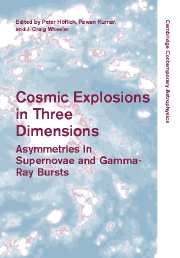Book contents
- Frontmatter
- Contents
- Part I Introduction
- Part II Supernovae: Observations Today
- Part III Theory of Thermonuclear Supernovae
- 10 Semi-Steady burning evolutionary sequences for CAL 83 and CAL 87: Super Soft X-ray binaries are supernova Ia progenitors
- 11 Type Ia progenitors: effects of spin-up of white dwarfs
- 12 Terrestrial combustion: feedback to the stars
- 13 Non-spherical delayed detonations
- 14 Numerical simulations of Type Ia supernovae: deflagrations and detonations
- 15 Type Ia supernovae: spectroscopic surprises
- 16 Aspherity effects in supernovae
- 17 Broad lightcurve SNe Ia: asymmetry or something else?
- 18 Synthetic spectrum methods for three-dimensional supernova models
- 19 A hole in Ia? Spectroscopic and polarimetric signatures of SN Ia asymmetry due to a companion star
- 20 Hunting for the signatures of 3-D explosions with 1-D synthetic spectra
- 21 On variations in the peak luminosities of Type Ia supernovae
- Part IV Theory of Core Collapse Supernovae
- Part V Magnetars, N-Stars, Pulsars
- Part VI Gamma-ray Bursts
- Part VII Conference Summary
- References
21 - On variations in the peak luminosities of Type Ia supernovae
Published online by Cambridge University Press: 11 August 2009
- Frontmatter
- Contents
- Part I Introduction
- Part II Supernovae: Observations Today
- Part III Theory of Thermonuclear Supernovae
- 10 Semi-Steady burning evolutionary sequences for CAL 83 and CAL 87: Super Soft X-ray binaries are supernova Ia progenitors
- 11 Type Ia progenitors: effects of spin-up of white dwarfs
- 12 Terrestrial combustion: feedback to the stars
- 13 Non-spherical delayed detonations
- 14 Numerical simulations of Type Ia supernovae: deflagrations and detonations
- 15 Type Ia supernovae: spectroscopic surprises
- 16 Aspherity effects in supernovae
- 17 Broad lightcurve SNe Ia: asymmetry or something else?
- 18 Synthetic spectrum methods for three-dimensional supernova models
- 19 A hole in Ia? Spectroscopic and polarimetric signatures of SN Ia asymmetry due to a companion star
- 20 Hunting for the signatures of 3-D explosions with 1-D synthetic spectra
- 21 On variations in the peak luminosities of Type Ia supernovae
- Part IV Theory of Core Collapse Supernovae
- Part V Magnetars, N-Stars, Pulsars
- Part VI Gamma-ray Bursts
- Part VII Conference Summary
- References
Summary
Abstract
We explore whether the observed variations in the peak luminosities of Type Ia supernovae originate in part from a scatter in metallicity of the main-sequence stars that become white dwarfs. Previous, numerical, studies have not self-consistently explored metallicities greater than solar. One-dimensional, Chandrasekhar mass models of SNe Ia produce most of their 56Ni in a burn to nuclear statistical equilibrium between the mass shells 0.2 M⊙ and 0.8 M⊙, for which the electron to nucleon ratio Ye is constant during the burn. We show analytically that, under these conditions, charge and mass conservation constrain the mass of 56Ni produced to depend linearly on the original metallicity of the white dwarf progenitor. This effect is most evident at metallicities greater than solar. Detailed post-processing of W7-like models confirms this linear dependence, and our calculations are in agreement with previous self-consistent calculations over the metallicity range common to both calculations. The observed scatter in the metallicity (1/3 Z⊙-3 Z⊙) of the solar neighborhood is enough to induce a 25% variation in the mass of 56Ni ejected by Type Ia supernova and is sufficient to vary the peak V-band brightness by |ΔMV| ≈ 0.2. This scatter in metallicity is present out to the limiting redshifts of current observations (z ≲ 1). Sedimentation of 22Ne can possibly amplify the variation in 56Ni mass to ≲50%. Further numerical studies can determine if other metallicity-induced effects, such as a change in the mass of the 56Ni-producing region, offset or enhance the variation we identify.
- Type
- Chapter
- Information
- Cosmic Explosions in Three DimensionsAsymmetries in Supernovae and Gamma-Ray Bursts, pp. 179 - 188Publisher: Cambridge University PressPrint publication year: 2004
References
- 1
- Cited by

